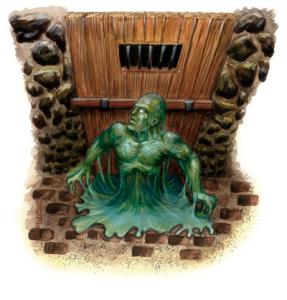
The Ghaunadan is a slime creature very much unlike any other in Dungeons & Dragons. In addition to being an ooze, it also is a shapechanger that can take the form of any kind of humanoid. It is also far from mindless like other oozes and instead a highly intelligent creature. It’s slime has a paralysis effect on living creatures and it also can easily disarm enemies by pulling their weapon into its body. A ghaunadan also has a limited form of charming gaze, which gives it a significant boost to all Charisma checks against a creature it has charmed, which makes ghaunadans excelent for infilitrating humanoid cities and palaces. Ghaunadans are associated with the ancient and evil god Ghaunaur, who rules over slimes and all kind of weird Underdark creatures and is sometimes worshiped by drow. Since all his traits are basically the same in every way as those of the demon lord Juiblex, I always consider them to be actually the same being. I don’t remember seing any hint of ghaunadans in any works older than this book, so it’s quite likely that they were inspired by the Shapechangers from Star Trek: Deep Space Nine, who are mostly the same thing but can also take the shape of objects and nonhumanoid creatures.
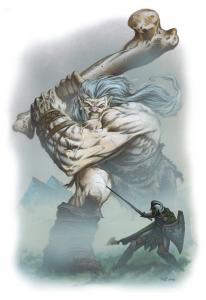
I can’t really say anything about the Fog Giant, other than it’s a giant without special abilities who ranks in power between a stone giant and a frost giant, but is taller than either. But look at this picture! When this guy hits you, you’re paste!
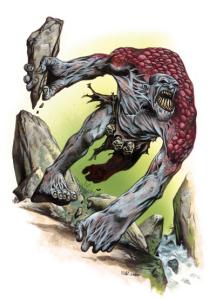
The Phaerlin Giant is a creature native to the Phaerlin region of the Underdark in the Forgotten Realms, which lies under the huge Anauroch desert and was once the location of the mighty wizard empire Netheril, but is under control of the phaerimms (more on those later). Phaerlin giants look like slightly mutated stone giants and live entirely underground, which I think is a neat idea. Reminds me of grimlocks. But their stats in this book are pretty wonkey. They are probably the only creature in D&D that is size category Huge and has a Challenge Rating of 3. Like any self respecting Underdark creature they have magic resistance and being primitive and feral they can sense nearby creatures by scent. Almost 70 hit points is also nothing to laugh at, but their backs are bent so badly that they move only very slowly. And for some unexplained, but nonmagical reason, they are so terrifying that characters who fight them have to make a saving throw or suffer penalties to all their attacks and saves because of fear. This is usually an ability reserved for the most powerful beasts and inhuman abominations. Here it just seems out of place. I like the cave giant from Pathfinder a lot more.
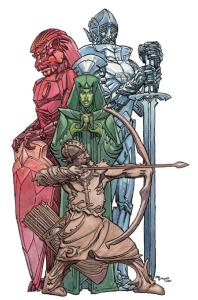
Usually I am not a fan of more types of golems, but the Gemstone Golems are a pretty cool idea. As golems go, they are not too terrifyingly powerful. But unlike other golems, the spirits that animate them are not forced to follow any order to the letter, which prevents them from any form of initative of creative planning, making them effectively mindless. Gemstone golems have more freedom, which makes them much more difficult to control, but also enables them to act and fight much more smarter. Unlike other golems, gemstone golems don’t have any really nasty trickes up their sleeves and attack simply by punching, but can be extremely difficult to damage. They don’t have a lot of hit points, but very high armor class and any weapon that is not heavily enchanted will just bounce off doing nothing. The ruby golem is the easiest to damage, but it also just regenerates almost all damage it takes. I’m not quite sure how players would even scratch these unless they know what needs to be done to damage them and also have the required (and very expensive) weapons at hand. I probably wouldn’t use these golems, but the idea of crystal golems that look like this is cool.
The Thayan Golem is a special kind of human sizes clay golem. It’s basically a terracotta archer. Unlike many other creatures in this book, the Challenge Rating for this one isn’t set too low, but much too high. This looks more like CR 4, not 8. As constructs it takes magic weapons to damage them, but it can also be done if you just hit them really hard. Their resistance to magic is also pretty low and not a huge problem. As seems tradition with this book, they have one completely random immunity, which is that they can not be harmed by the magic missile spell. I’m sure that will come up a lot in actual play. Obviously, these golems are made by the Red Wizards of Thay.
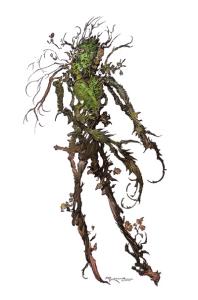
The Green Warder is a living plant, though I would probably make it a fey instead. But treants are also plants in D&D, so yeah. Green warders can be found in the great forest Cormanthor, where they used to be used as guardians by the elves of the great ancient city Myth Drannor. They are exceptionally well suited for that task, and given the great magical power of Myth Drannor, I wouldn’t be surprised if these creatures were created through magic. A green warder consists of leafy vines that are grown to roughly the shape of a tall elf and are relatively smart, though somewhat simple minded creatures. They are not very strong or tough and their claws do only little damage, but obviously they are extremely good at hiding themselves among plants. They also have some very useful magic abilities. They can use the sleep and confusion spells to neutralize intruders, but any time a creature successfully resists these it becomes increasingly more resistant against them for the rest of the day. So simply spamming these spells over and over until an intruder drops isn’t going to work. They also can set up alarm spells which create a loud birdcall whenever an intruder steps into the warded area, allerting the green warders and elven sentinels nearby. Green warders aren’t really dangerous, but as support troops for elven or other woodland armies they can be really effective additions.
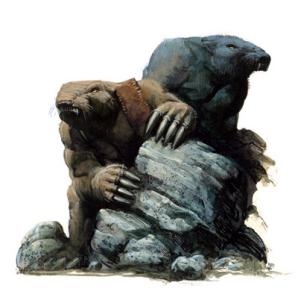
Groundlings are another magical creation, but this time not by the Red Wizards of Thay, but by the Zhentarim. While the Zhentarim are controlled by the priests of Bane, who create all those Bane creatures shown earlier, groundlings are created in the main stronghold of a rival faction within the Zhentarim. They are still the same gang, though. A groundling is a badgerlike creature created through magic from a dwarf. And I think the illustration does a good job of showing that relationship. Supposedly Zhentarim wizards create them to hunt down their enemies, but groundlings are not really very dangerous and I don’t see how they would be a useful resource for Zhentarim leaders, who have a lot more dangerous minions in their ranks. Still, I quite like the look and think there could be something interesting done with them. They are probably from some kind of adventure, where they have a bit more context.
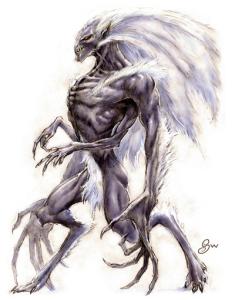
The Dreagloth is what The Tygre described as “the aftermath of a Black Metal album cover”. A draegloth is a specific type of half-demon created from a drow priestess of Lolth and a glabrezu demon (which is a 5 meter tall giant with four arms and a dog face). And it looks exactly as you’d expect it. A two and a half meter giant drow with four arms and a somehwat doglike face. A draegloth is violent and savage, but actually highly intelligent just like its parents, and gains most of the immunities from either side. I think they first appeared in the seventh or eighth Drizzt novel, but I hadn’t seen any picture of one until this one. And it absolutely kicks ass. A draegloth is like a blend of Wolverine and Blanka, just as pure and bloodthirsty incarnation of violence. I actually quite liked the War of the Spiderqueen novels and I think the draegloth Jeggred was one of the coolest characters. With the rest of the characters all being archwizards and high priestesses, they often underestimated him and dismissed him as stupid. But draegloths aren’t stupid or unaware of the finer details of intrigue that go on around them. They just don’t give a fuck about anything and exist only for carnage.

Correction: Thayan Golems are Wood Golems made of Thayan Oak, not Clay Golems.